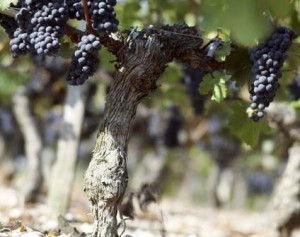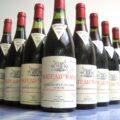November 7 is International Merlot Day. Not that Merlot lovers need a reason to open a bottle wine. But as it is International Merlot Day, it is time to celebrate and take a look at all things Merlot.
When asked for the most widely planted grape in Bordeaux, many wine lovers would say Cabernet Sauvignon. That is not the case. There are more hectares devoted to Merlot than any other grape in Bordeaux. To give you an idea on how much Merlot is planted in Bordeaux, close to 62% of all vines in Bordeaux are Merlot taking up about 69,138 hectares. Cabernet Sauvignon is a distant second with about 25% of the region’s planting’s totaling close to 28,347 hectares.
Merlot is not only popular in Bordeaux. In fact, it’s the most widely planted grape in France! Merlot is also successfully planted in Switzerland, Australia, Argentina and numerous other countries, as well as in America. But Merlot offers its best expression in the soils of Bordeaux. Alexandre Thienpont, the owner of Vieux Chateau Certan explains what Merlot adds to their wine.
Alexandre Thienpont “In the Right Bank it is the base of the wine. It gives color, density, tannins, richness and concentration.”
Merlot thrives best in the clay and limestone soils of Pomerol, St. Emilion and Lalande de Pomerol. Read about the terroir and soil of Bordeaux Christian Moueix knows a thing or two about Merlot as the owner of Trotanoy and La Fleur Petrus in Pomerol. Christian Moueix finds Merlot perfectly combines feminine and opulent qualities.
Christian Moueix “Merlot is a friendly and delicate varietal which, on the proper terroirs and harvested at its peak, produces wines characterized by voluptuous, generosity and distinction.”
A few estates in Pomerol make wine from 100% Merlot wine, most notably Petrus. Some estates in St. Emilion also make wine using only Merlot. However, most Bordeaux wines are a blend of two or more varietals. Vieux Chateau Certan is one of the most famous chateau in Pomerol for their unique blend of Merlot with Cabernet Franc. According to the owner, Alexandre Thienpont, it is the blending that adds the extra special dimension to Vieux Chateau Certan.
Alexandre Thienpont “A wine made from 100% Merlot is for me a simple wine, but in a in a positive way. As my retired oenologist used to say, everybody likes barbecue, but a blend wine is haute cuisine! A blended wine is multidimensional, instead of a monovarietal wine which is mono dimensional as it is the case even for Burgundian Pinot Noir.”
Jean Christophe Meyrou has a lot of experience with Merlot. He was responsible for the rebirth of Chateau Le Gay and Chateau La Violette in Pomerol and at Chateau Fonplegade in St. Emilion. He often prefers Merlot wines when blended.
Jean Christophe Meyrou “There are not many places where you can make a 100% Merlot wine that has the same quality that you find in Pomerol. In most appellations, for example St. Emilion, Cabernet Franc will be needed in the wine to help add backbone to the final cuvee.”
Jean Michel Laporte of Chateau La Conseillante agrees with the sentiment of Meyrou, regarding wines with Merlot as part of the blend.
Jean Michel Laporte “In Europe and in Bordeaux in particular, we almost always blend our wines. Another variety brings more complexity to the wine. It is also a perfect fit with the mosaic of soils we can have. At La Conseillante for example, we have clays on one side and gravels on the other side. Merlot is perfect on clays, and great on gravels. However, Cabernet Franc is just marvellous, but only on the gravel soil. This duo of terroirs is the essence of La Conseillante. We couldn’t get that without a blend. For me, 100% Merlot wines miss something. But if the terroir only demands Merlot, like at Petrus, which is the best Merlot wine I have ever tasted, go for it!”
Merlot deserves credit for making the world’s most hedonistic, opulent and decadent tasting experiences. Those are all found in the best wines from Pomerol and St. Emilion. Bordeaux produces a lot of wine in a myriad of price ranges. But the most expensive wines of Bordeaux are the Merlot based wines of Pomerol. Petrus, Le Pin and Lafleur all sell for over $1,000 per bottle. In St. Emilion, Chateau Cheval Blanc and Chateau Ausone are not far behind. All those wines routinely fetch higher prices than even the First Growths!
The choice of when to pick Merlot is one of the most important factors for the quality and style of a wine. Jean Michel Laporte of Chateau La Conseillante in Pomerol looks at a myriad of factors when deciding on the right moment to harvest.
Jean Michel Laporte “As with any other grape variety, we are concerned by the phenolic maturity: color and tannin potential, their extractability and the ripeness of the seeds in our Merlot. At La Conseillante, we don’t really care about the sugar contents, as we don’t look after high alcohols. We prefer when acidity levels remain quite high. This helps to preserve the balance in the wine and the freshness of the aromas. It’s also important to remember, Merlot is more fragile than other grapes regarding the botrytis. This point can become a major concern in Bordeaux. Fortunately, because Merlot is an early ripening grape, it does not often become a problem.”
Alexandre Thienpont of Vieux Chateau Certan naturally produces a different expression of Merlot and Pomerol than Chateau La Conseillante. He explains what they seek when deciding when to harvest.
Alexandre Thienpont “At Vieux Chateau Certan we look for optimum ripeness. The alcohol degree is not the target. We are more interested in the ripeness of the tannins, the internal part of the skin and extractibility. We need small berries with ripe skins and concentrated aromas of ripe fruit.”
Florence Decoster of Chateau Fleur Cardinale in St. Emilion is almost always the last major estate to finish harvesting in the Right Bank. She explains that they strive to maintain freshness along with plush textures in the Merlot grapes used in their wine.
Florence Decoster “Merlot is a grape variety that gives round and delicious wines, with aromas of black fruits such as black cherry, blackberry and cassis. You also get aromas of truffle, violet, plum, chocolate. For Merlot, our aim is to maintain the freshness of the fruit, before it becomes too soft and loses its freshness.”
While Merlot is the dominant grape in the Right Bank, it is used a blending grape in the Medoc for its unique ability to tame the strong tannins and structure found in the Cabernet Sauvignon grown in the Left Bank as well as in Pessac Leognan. When asked what is the key to growing great Merlot, Xavier Pariente of Chateau Troplong Mondot says it’s a combination of 4 things that all starts with the terroir!
Xavier Pariente “Great Merlot consists of 4 important elements; the adapted terroir, the adapted terroir and then a great terroir and finally, a little of a man’s or woman’s hand!”
In the Medoc, Chateau Pichon Lalande and Chateau Palmer have large percentages of Merlot planted in their vineyards. However, the vineyards in the Medoc with the highest concentration of Merlot planted are Chateau Pibran in Pauillac with close to 55% and Chateau Coufran with a whopping 85% Merlot in their Haut-Medoc vineyards! Jean Luc Thunevin of Valandraud fame feels Merlot is a perfect blending grape.
Jean Luc Thunevin “Wines made from 100% Merlot are quite rare. In the Right Bank, Merlot blends perfectly with Cabernet Franc. Cabernet Franc brings more structure and aromas to the Merlot.”
In character, Merlot offers flavors of chocolate, plums, licorice, black cherries, blueberries, black raspberries and blackberries as well as jam, which depends on the levels of ripeness the fruit was allowed to achieve. It is round, fleshy and can be opulent in texture. These qualities are found most often in Pomerol and St. Emilion. But Bordeaux is not the only region where Merlot is planted. While they are of course different expressions of Merlot, the grape can be quite successful in other appellations around the world as well. Jean Michel Laporte recalls tasting some very good Merlot wines from California and Italy.
Jean Michel Laporte “I remember wines from Shafer and Palhmeyer. But I miss a little bit of freshness on Merlot out of Bordeaux. Its high need for maturity has to be balanced by the climate. California is often a bit too warm for it. I have really liked some of the Super Tuscans from Italy like
Ornellaia.”
Jean Christophe Meyrou seems to share a similar view of Merlot wines from around the world. But he differs on his thoughts of Super Tuscans.
Jean Christophe Meyrou “I wish you had asked me the same question about Cabernet Sauvignon. Then I would have mentioned Napa Valley for example. In the new world most of Merlot wines I tasted were technically well made. But sometimes they became a bit boring after the first glass. I am not convinced by Merlot I tasted from Italy or Spain. I am a very open minded person. But with Merlot I have to say, I never fall in love with the wines in the same way I do a top wine from Pomerol or St. Emilion.”
Personally, I have experienced a few Super Tuscan Merlot wines that blew me away, most notably, Massetto and Messorio. At the end of the day, there are a plethora of different Merlot based wines to choose from, each with their own style and character. Regardless of the Merlot wine you prefer, why not grab a bottle of something special and celebrate International Merlot Day November 7? I know I will!






28 Comments
#InternationalMerlotDay What are you opening to celebrate? https://t.co/KaO2qMMLX7 https://t.co/RrbErEf5Mx
RT @bigandfruity: It’s International Merlot Day What are you Drinking to Celebrate? Read more here: https://t.co/hyK8u3mm5d @JeffLeve @dav…
It’s International Merlot Day What are you Drinking to Celebrate? Read more here: https://t.co/hyK8u3mm5d @JeffLeve @daveac #Merlot #wine
RT @emilyoyoung: Happy International Merlot Day https://t.co/h12X9tAU7D https://t.co/vsua2o3ifE
Happy #NationalMerlotDay Here’s some info on this fantastic grape — now stop in and pick up a bottle! https://t.co/8UBszf4oni
Happy #NationalMerlotDay Here’s some info on this fantastic grape — now stop in and pick up a bottle! https://t.co/056t7p8Bex
Happy #NationalMerlotDay Here’s some info on this fantastic grape — now stop in and pick up a bottle! https://t.co/fbiyKdmvSQ
Happy #NationalMerlotDay Here’s some info on this fantastic grape — now stop in and pick up a bottle! https://t.co/nH6VtU91tR
Happy #NationalMerlotDay Here’s some info on this fantastic grape — now stop in and pick up a bottle! https://t.co/hl3kY6wwuS
RT @emilyoyoung: Happy International Merlot Day https://t.co/h12X9tAU7D https://t.co/vsua2o3ifE
Happy International Merlot Day https://t.co/h12X9tAU7D https://t.co/vsua2o3ifE
International Merlot Day – What are you Drinking to Celebrate November 7?https://t.co/HWsK4S5M0B #merlotday #merlot Thanks @JeffLeve!!
RT @grande_provence: Let’s cheers to International Merlot Day – one of the world’s best loved wine varieties http://t.co/7lD3LGOv4x
I just found out I missed international #merlot day by 5 days http://t.co/UzmnVDWVC0
International Merlot Day What are you Drinking to Celebrate November 7 http://t.co/SUjgxLWKFg
International #Merlot Day is Now! Please Retweet to help get the word out & pop a bottle of Merlot #wine to celebrate http://t.co/2ZcnVWHpcJ
.@BordeauxWines Thanks for the mention about International Merot Day! Several #Bordeaux winemakers discuss Merlot http://t.co/2ZcnVWHpcJ
RT @JeffLeve: Alexandre Thienpont Vieux Chateau Certan talks about Merlot in Pomerol for International Merlot Day http://t.co/2ZcnVWHpcJ
Florence Decoster Fleur Cardinale talks about Merlot in St. Emilion for International Merlot Day http://t.co/2ZcnVWHpcJ
RT @JeffLeve: Jean Michel Laporte La Conseillante talks about Merlot in the Right Bank for International Merlot Day! http://t.co/2ZcnVWHpcJ
Jean Luc #Thunevin talks about Merlot at #Valandraud for International Merlot Day http://t.co/2ZcnVWHpcJ
Jean Michel Laporte La Conseillante talks about Merlot in the Right Bank for International Merlot Day! http://t.co/2ZcnVWHpcJ
Alexandre Thienpont Vieux Chateau Certan talks about Merlot in Pomerol for International Merlot Day http://t.co/2ZcnVWHpcJ
Great article Jeff! The wine maker quotes are great. After reading everything from Mr. Laporte, we will be opening one of our prized bottles of La Conseillante.
Thanks for the post Steve. La Conseillante is the perfect choice. In fact, I am going to open a bottle this weekend as well!
Great article Jeff! The wine maker quotes are great. After reading everything from Mr. Laporte, we will be opening one of our prized bottles of La Conseillante.
RT @JeffLeve: Tomorrow, November 7 is International #Merlot Day! What are you opening to celebrate? http://t.co/2ZcnVWHpcJ
November 7 International Merlot Day What are you Drinking to Celebrate http://t.co/yUKwy9BtDH